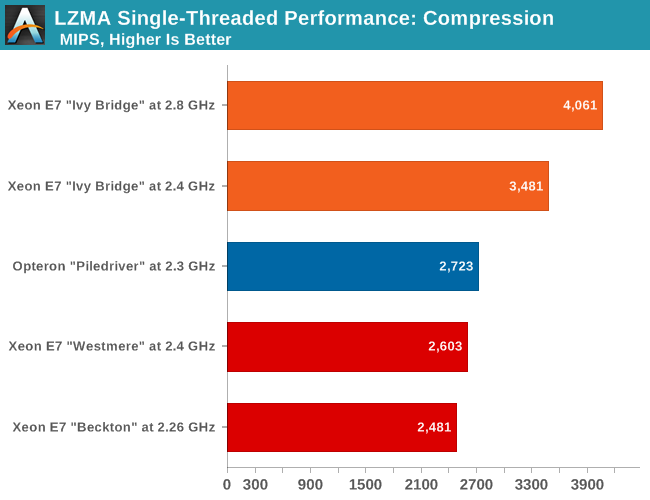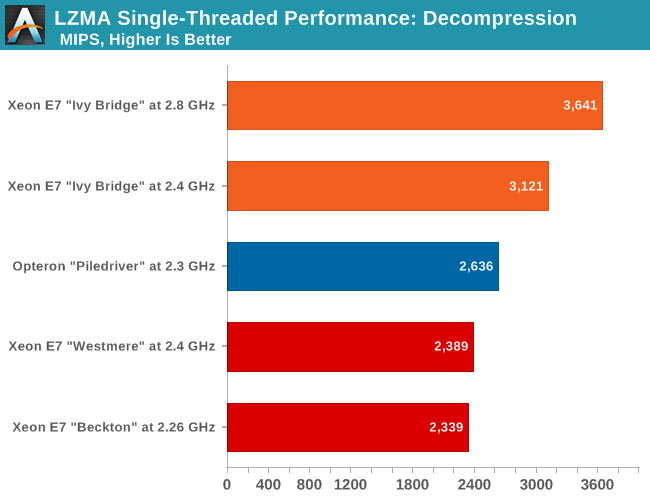The Intel Xeon E7 v2 Review: Quad Socket, Up to 60 Cores/120 Threads
by Johan De Gelas on February 21, 2014 6:00 AM EST- Posted in
- IT Computing
- Intel
- Xeon
- Ivy Bridge EX
- server
- Brickland
Single-Threaded Performance
I admit, the following two benchmarks are almost irrelevant for anyone buying a Xeon E7 based machine. But still, we have to quench our curiosity: how much have the new cores been improved? There is a lot that can be said about all the sophisticated "uncore" improvements (cache coherency policies, low latency rings, and so on) that allow this multi-core monster to scale, but at the end of the day, good performance starts with a good core. And since we have listed the many subtle core improvements, we could not resist the opportunity to check how each core compares.
The results aren't totally meaningless either, as the profile of a compression algorithm is somewhat similar to many server workloads: hard to extract instruction level parallelism (ILP) and sensitive to memory parallelism and latency. The instruction mix is a bit different, but it's still somewhat similar to many server workloads. And as one more reason to test performance in this manner, the 7-zip source code is available under the GNU LGPL license. That allows us to recompile the source code on every machine with the -O2 optimization with gcc 4.8.1.
We've run an additional data point for this particular set of tests. The new Ivy Bridge EX was tested at 2.8GHz and downclocked to 2.4GHz, so that we can do a clock-for-clock comparison with Westmere EX. Since we're only testing single-threaded performance here, other than perhaps slight differences due to having more total L3 cache, it doesn't matter which particular E7 v2 chip we use.

The latest Xeon E7 v2 "Ivy Bridge EX" is capable of extracting 33% more ILP out of the complex compression code than the older Xeon E7 "Westmere-EX" at the same clock speed. That is pretty amazing and shows how all the small micro-architecture improvements have accumulated into a large performance increase. The Opteron core is also better than most people think: at 2.4GHz it would deliver about 2481 MIPs. That is about 80% of Intel's best server core at the moment—not enough, but nothing to be ashamed about.
Also interesting to note is that the Westmere core was indeed a "tick": any performance increase over the Xeon X7560 (Codename "Beckton", 45nm Nehalem core) is simply the result of the higher clockspeed of the 32nm chip.
Let us see how the chips compare in decompression. Decompression is an even lower IPC (Instructions Per Clock) workload, as it is pretty branch intensive and depends on the latencies of the multiply and shift instructions.

Again, we note a 30% improvement in integer performance going from the Xeon E7 "Westmere" (Xeon E7-4870 at 2.4GHz) to the Xeon E7 v2 "Ivy Bridge EX" (Xeon E7-4890 v2 clocked down to 2.4GHz).
To summarize: the new 15-core Xeon E7 v2 is built upon a strong core architecture that has improved significantly compared to the predecessor.










125 Comments
View All Comments
TiGr1982 - Friday, February 21, 2014 - link
I think, 6 cores on desktop for $300 will NOT happen this year.Because if it will, then you'll get $300 4 core i7 on mainstream 1150 & $300 6 core i7 on new 2011 simultaneously on the market.
To adjust this, they'll have to sell 1150 4 core i7 for $200-$220, like Core i5 now.
This is not realistic, because that's Intel we're talking about, right?...
dragonsqrrl - Friday, February 21, 2014 - link
That's actually the plan, except it won't be $300. I think the latest leaks suggest that the lowest end Haswell-E SKU will be a 6-core K series at ~$400. The other two price points remain about the same, $600 and $1000 for the 8-core SKU's.TiGr1982 - Saturday, February 22, 2014 - link
To me, seems too good to be true. Will require a major change of mindset inside Intel to start selling 6 core for $400 and lower 8 core for $600 :)(while 8 core XE for $1000 is not surprising at all)
Harry Lloyd - Saturday, February 22, 2014 - link
The thing is LGA2011 mobos are really expensive, so the CPU price does not have to be that high. You can get a good B85 mobo even for less than 100 $, and an LGA2011 mobos start at 250 or even 300 $.I would not pay 300 $ for a mobo, and 400 $ for a 6-core CPU, that would still be ridiculous. I hate this stagnation. The transision from 1-core to 4-core happend really quickly.
MrSpadge - Saturday, February 22, 2014 - link
The smallest 6-core K model has been around 500$ for quite some time, so I see no problem going to 400$ this time. 8 cores for 600$ would indeed be a significant step for some, though.psyq321 - Monday, March 10, 2014 - link
Well, if Intel manages to castrate the HEDT "E" version enough so that it does not pose any threat to their Xeon revenue, price drop might happen.However, one factor not to be underestimated is total available market and how much are target consumers for this kind of hardware willing to pay. I have no data, but for some reason I think only small % of "power users" (>very< power users) need 8 cores today and they would probably be willing to shell out $1000.
Thing is, if you are Intel, you will probably making the calculation: what if we drop the price to, say, $600? Is this going to bring us more customers? Is this going to cannibalize some of, more lucrative, Xeon market?
I suppose if Intel fuses out TSX, VT-D, ECC memory support and, of course, QPI (which is what they do anyway with Sandy-E and Ivy-E HEDT CPUs) the chip would practically be next to useless to most Xeon customers. So the remaining issue is the market.
f0d - Friday, February 21, 2014 - link
i agreei was hoping for 8 core ivy bridge-e chips but had to settle for 6 cores which i can easily use all of
i do a LOT of video encoding using handbrake and that program just loves cores, i easily saturate all 12 threads with my settings in handbrake so i do believe it could use a single socket 8 core well (i have read tests that show handbrake not liking dual/quad socket systems for more cores - but does improve when using lots of cores on a single socket)
MT007 - Friday, February 21, 2014 - link
You have a error on page 8, in your fourth paragraph you have the opteron as 2.4ghz and only with a score of 2481. From your graph it should have been 2.3ghz and 2723?webmastir - Friday, February 21, 2014 - link
They don't tend to fix errors/read comments I don't think.JohanAnandtech - Friday, February 21, 2014 - link
Sure we do :-)